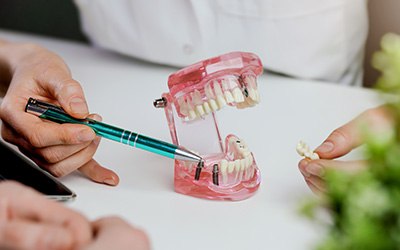Dental Implant Failure & Salvage – Cincinnati, OH
Save Failing Dental Implants with Implant Salvage Treatment

Dental implants have an extremely impressive track record for success. Unfortunately, however, they still can fail, even many years after placement. The good news is that if this does happen, Kemper Meadow Family Dentistry may be able to help get your smile back on track with dental implant salvage treatment.
Why Do Dental Implants Fail?

There are many reasons why your dental implant may fail. The most common cause is a condition known as peri-implantitis. This occurs when a bacterial infection destroys the connective tissue surrounding the implant, weaking the supporting jawbone structure. Peri-implantitis is frequently caused by poor oral hygiene and gum disease.
Other factors that could cause dental implant failure include an injury to the jaw, failed osseointegration following surgery, and various medical conditions such as cancer.
Symptoms of a Failed Dental Implant

Dental implant failure can occur at any time, even many years after your implant was initially placed. Early dental implant failure often happens in the healing period immediately after placement. Later failure can occur many years or even decades after surgery. Here are a few indications that your dental implant may be failing:
- A loose implant that may move when eating or speaking.
- Redness, swelling, or pain at the dental implant site.
- An infection at the dental implant site.
How Dental Implant Salvage Works

If you notice any warning signs of immanent dental implant failure, don’t hesitate to contact Kemper Meadow Family Dentistry as soon as possible. The earlier we can intervene, the easier and more affordable your failing implant may be to treat.
With dental implant salvage, it may be possible to save your failing dental implant, but time is of the essence. Salvaging your restoration may require additional procedures such as removing the implant and surgically reimplanting it. Before this can be done, however, you may need some preliminary treatment such as a bone graft or gum disease therapy.
The surgical procedure for reimplantation is similar to your initial treatment and will require a healing period for osseointegration to occur. During this time, you will need to closely follow the aftercare instructions provided by your dentist, eat a soft diet, refrain from using tobacco products of any kind, and maintain proper oral hygiene.
